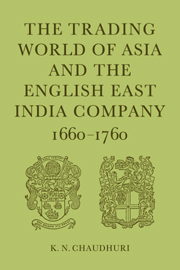Book contents
- Frontmatter
- Contents
- Tables
- Figures
- Maps
- Abbreviations
- Notes on dates, contemporaneous spellings, currency, and weights
- Preface
- Acknowledgements
- 1 The international economy and the East India trade
- 2 A formal theoretical model of the East India Company's trade
- 3 The structure of early trade and the pattern of commercial settlements in Asia
- 4 The evolution of the Company's trading system: operation and policy 1660–1760
- 5 Long-term trends and fluctuations 1660–1760
- 6 Politics of trade
- 7 Markets, merchants, and the Company
- 8 The export of treasure and the monetary system
- 9 The structure of country trade in Asia
- 10 Export of European commodities
- 11 The Company and the Indian textile industry
- 12 The Company's trade in textiles
- 13 Pepper
- 14 Import of bulk goods
- 15 Raw silk
- 16 Coffee
- 17 Imports from China
- 18 Financial results
- 19 Conclusion
- APPENDICES
- 1 Notes on the statistical tables of the East India Company's trade
- 2 Time-series analysis of the East India Company's exports and imports
- 3 The econometric estimation of the trading model
- 4 The grouped list and the glossary of Indian textile types
- 5 The statistical tables of the Company's trade
- General glossary
- Bibliography
- Short titles cited in the reference notes
- Notes
- Index
1 - Notes on the statistical tables of the East India Company's trade
from APPENDICES
Published online by Cambridge University Press: 06 July 2010
- Frontmatter
- Contents
- Tables
- Figures
- Maps
- Abbreviations
- Notes on dates, contemporaneous spellings, currency, and weights
- Preface
- Acknowledgements
- 1 The international economy and the East India trade
- 2 A formal theoretical model of the East India Company's trade
- 3 The structure of early trade and the pattern of commercial settlements in Asia
- 4 The evolution of the Company's trading system: operation and policy 1660–1760
- 5 Long-term trends and fluctuations 1660–1760
- 6 Politics of trade
- 7 Markets, merchants, and the Company
- 8 The export of treasure and the monetary system
- 9 The structure of country trade in Asia
- 10 Export of European commodities
- 11 The Company and the Indian textile industry
- 12 The Company's trade in textiles
- 13 Pepper
- 14 Import of bulk goods
- 15 Raw silk
- 16 Coffee
- 17 Imports from China
- 18 Financial results
- 19 Conclusion
- APPENDICES
- 1 Notes on the statistical tables of the East India Company's trade
- 2 Time-series analysis of the East India Company's exports and imports
- 3 The econometric estimation of the trading model
- 4 The grouped list and the glossary of Indian textile types
- 5 The statistical tables of the Company's trade
- General glossary
- Bibliography
- Short titles cited in the reference notes
- Notes
- Index
Summary
Sources of statistics
The main sources of quantitative information on the English East India Company's official trade are the account books. These fall into two broad generic groups based on the geographical origin of the records: (a) the books kept by the Company's Accountant General's Department in London, and (b) the books originally compiled by the trading establishments in various parts of the Indies and sent over to London periodically. The first group can be divided further into three different types of account books: (i) the Commerce Journals, (2) General Ledger Books, and (3) the Cash Books. Group (b) comprises only (i) Commerce Journals and (ii) Ledger Books. Miscellaneous information is also available in the Company's outward letters preserved in the Despatch Books, Home Miscellaneous Series, and the Memoranda of the Committee of Correspondence, but the statistics contained in these records are not systematic nor are they of a long-run nature. The early Despatch Books give the names of the ships sailing for the Indies together with a summary of their cargo and its total value. However, the practice was discontinued from the 1680s. The Home Miscellaneous Series contains statistics covering four different areas of the Company's trade: exports to Asia, sales of import commodities, finance including its balance-sheets, list of shareholders, and capital stock, and finally the foreign exchange and bullion business of the Company.
- Type
- Chapter
- Information
- The Trading World of Asia and the English East India Company1660-1760, pp. 463 - 476Publisher: Cambridge University PressPrint publication year: 1978



